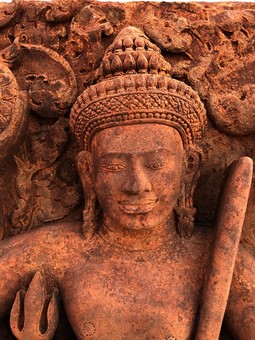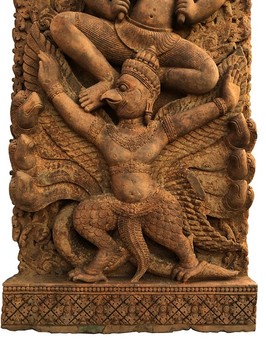featured item
khmer vishnu riding garuda, 11th century
- View other items in:
- antique asia and the far east
- oriental antiques
tevoda gallery
Enquire about this antique
Tevoda Gallery has 9 antiques for sale.
click here to see them all
KHMER VISHNU RIDING GARUDA
Angkor Period, style of Angkor Wat,
11th Century
Sandstone
Height 112cm, Width 57cm,
Antiques.co.uk Ref: G4QHNMX6
- Materials:
- Sandstone
- Width (cm):
- 57
- Height (cm):
- 112
Please note that this price may NOT include delivery charges which the seller may charge extra for.
Tevoda Gallery
Tevoda Gallery Southeast Asian art gallery
HISTORY OF KHMER ART
THE PRE-ANGKORIAN PERIOD (2nd half of the 6th century – beginning of the 9th century)
Phnom Da Style (514-600)
Sambor Prei Kuk Style(600-650)
Prei Khmeng Style (635-700)
Prasat Andet Style (657-681)
Kompong Preah Style (706-800)
(THE TRANSITIONAL PERIOD)
Kulen Style (802-875)
THE ANGKORIAN PERIOD (9th century - 1431)
Preah Ko Style (875-895)
Bakheng Style (893-925)
Koh Ker Style (921-945)
Pre Rup Style (944-967)
Banteay Srei Style (967-1000)
Khleang Style (965-1010)
Baphuon Style (1010-1080)
Angkor Vat Style (1100-1175)
Bayon Style (1180-1230)
THE POST-ANGKORIAN PERIOD (1431 - the present)
THE PRE-ANGKORIAN PERIOD (2nd half of the 6th century – beginning of the 9th century)
It is generally accepted that this period begins with the fall of Fu-nan and ends, not with the founding of Angkor, which did not take place until the last years of the 9th century, but with the introduction (in the first half of the 9th century) of the rites upon which the kingship of Angkor was to be based. The oldest (Buddhist) images are no earlier than the middle of the 6th century. The somewhat later (early 7th century and period following) Brahminic monuments already exhibit some of the traditional features of Khmer architecture. There exist only a few fine examples of Pre-Angkorian art. This period marks the beginnings of the Khmer world, in which a distinct personality gradually affirms itself, while globally remaining under foreign influences. The belief in the cult of the 'god-king', do not as yet exist. Nevertheless, the art of this period lays down the basis for sculptural symbolism, and inaugurates architectural forms which will be reused and later improved upon. Pre-Angkorian statuary witnesses an Indian influence, but anatomical representation is less dramatic. Sculptors used a support arch for figurative representations with many arms. Stone sculpture is characterized by its delicacy of execution, as well as its respect for plastic and anatomical form.
Phnom Da Style (514-600)
Sculpture: Evolution of statuary from high relief to free-standing sculpture. The works display typical Indian movement of the torso, often with a support arch to provide stability.
Contact details
199/24 M.20
Ubon Ratchathani
34110
THAILAND
T: +66 959957471
E: service@tevoda.com
W: www.tevoda.com
















